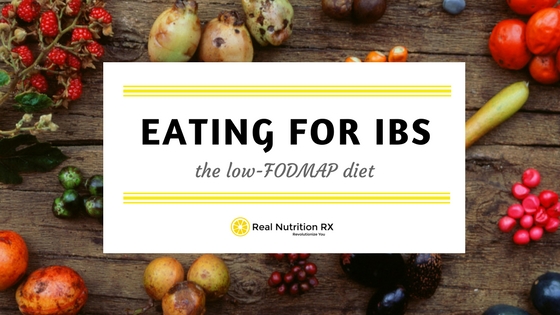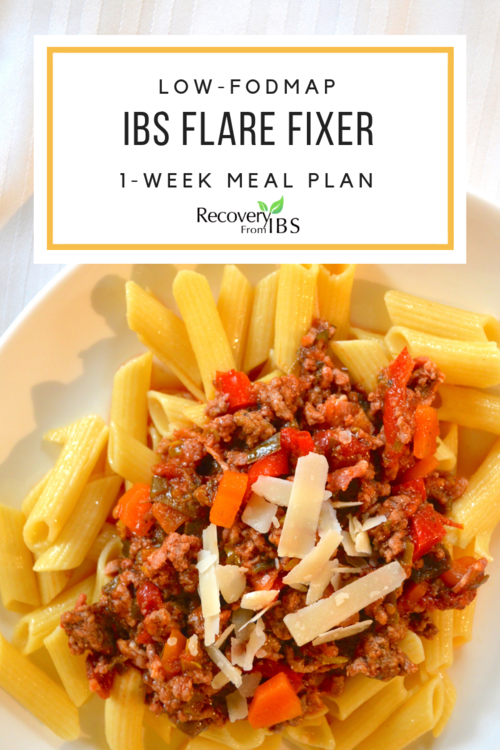Eating for IBS – The Low FODMAP Diet – From a Registered Dietitian Nutritionist

Hi and welcome to the first of a series on eating for IBS. In this post Ill be giving an overview of the low-FODMAP diet.
Spoiler alert – at the end of this post Ill share a resource that is likely to greatly improve your IBS inside of a week – dont miss it!
Of the possible diets for IBS, the low-FODMAP diet has the most scientific evidence supporting it. There are literally hundreds of peer-reviewed journal articles supporting the efficacy of the low-FODMAP diet for improving IBS symptoms.
The amazing this about the low-FODMAP diet is that for many people it nearly completely eliminates their IBS – with diet alone! Ive seen it many times in my practice.
However, its also important to remember that some people are non-responders – around 20-25% of people with IBS will not feel better on a low-FODMAP diet. In these cases, a different diet and/or further investigation and treatment are needed.
What are FODMAPs?
So, what are FODMAPs? FODMAP is an acronym that stands for fermentable oligosaccharides, disaccharides, monosaccharides and polyols (phew!) You dont need to memorize that. What you need to know is that this refers to specific carbohydrate molecules within foods that are not well digested and absorbed. The word ‘fermentable refers to the fact that these molecules ARE digested by the bacteria that live in our digestive tract. These bacteria readily break down and consume FODMAPs.
Why eliminate FODMAPs?
There are two primary problems with FODMAPs for people who have IBS:
1. The first is that when bacteria digest them, gas is produced as the waste product. This gas production within the digestive tract can cause bloating, abdominal pain, and altered bowel habits (diarrhea, constipation, or a mix of the two). Of course, it also causes flatulence and can even cause reflux or GERD.
2. The second problem with FODMAPs is that, because they are poorly digested by us, they remain in in the digestive tract as the food passes through. This increases the osmolality of the solution inside the gut, which causes water to get pulled in. As water gets pulled into the gut, this further exacerbates symptoms like bloating, cramping, abdominal pain, and diarrhea.
Eliminating problematic FODMAPs will improve these problems. However, its important to keep something in mind – a low-FODMAP diet does NOT address the underlying cause of IBS! The diet is a good starting point for feeling better, but its important to then go further and investigate/treat the cause. You can learn more about the causes and treatments of IBS from the ‘IBS Recovery 101 series.
So, how does FODMAP elimination work?
It is extremely important to understand that the low-FODMAP diet is an elimination diet. What that means is that all FODMAPs are removed from the diet for an initial period of 2-4 weeks, and that foods are then REINTRODUCED in a systematic way. Most IBS patients are not sensitive to all FODMAPs, so some types can be brought back into the diet without ill effect. The full elimination diet (with all FODMAPs removed) is not intended to be a long-term diet. Reintroductions improve the nutrient profile and ease of the diet.
One common misperception about a low-FODMAP diet is that it will adversely affect the microbiome (healthy bacteria in your gut) by starving it of fiber. Recent studies have shown that this is not, in fact, the case. When subjects were guided by a Registered Dietitian to reintroduce FODMAPs in a systematic way, their fiber intake was adequate and their microbiome was not adversely effected. However, remaining on the full elimination diet for too long HAS been shown to adversely effect the microbiome. So, the reintroduction phase is critical!
In brief, the way that FODMAP reintroduction works is by category – so one type at a time, with increasing quantities of that type. An experienced professional can help guide you through this process.
How to get started with a low-FODMAP diet
Technically, you should work with a trained Registered Dietitian to get started. When I start with a client, I collect a lot of information to determine if this or another diet is most appropriate (such as SIBO, Specific Carbohydrate, GAPS, etc). I also will recommend testing and supplements that may further improve symptoms, replete nutrients, and support healing. Then, I will follow up with them to support and guide as needed.
However, I get that not everyone can work 1:1 with a dietitian. Two excellent books for getting started are:
1. The IBS Elimination Diet and Cookbook by Patsy Catsos, MS, RDN, LD
2. The Complete Low-FODMAP Diet by Sue Shepherd, PhD, and Peter Gibson, MD
I also recommend the Monash University low-FODMAP app as a great resource.
OR – this is what I recommend the most – dont memorize the low-FODMAP diet at all until you know if it works for you! Ive made a 1-week low-FODMAP meal plan that you can get for free. Download it and give it a try for a week! If you feel better, you know that the low-FODMAP diet holds promise for you.
Try it for a week!
Don’t miss my FREE one-week ‘IBS Flare Fixer’ meal plan! It’s low-FODMAP, nutrient-dense, easy, and delicious!
It’s your ticket to try Low-FODMAP (done right) without having to figure it all out first.
It’ll have you feeling better inside of a week!
Id love to hear from you – what questions do you have about the low-FODMAP diet? I’ll be continuing this series based on your feedback! Feel free to leave you questions in the comments or to contact me directly.
Finally, don’t miss any future updates! You can follow Real Nutrition RX using any of the links below:

